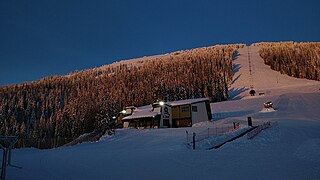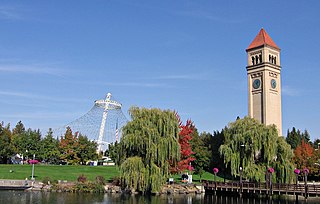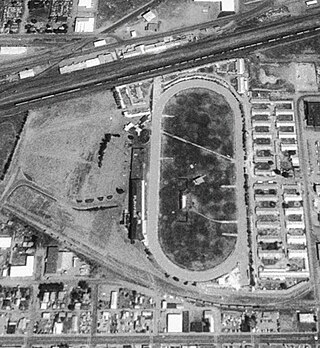Related Research Articles

Spokane is the most populous city in and seat of government of Spokane County Washington, United States. It is in eastern Washington, along the Spokane River, adjacent to the Selkirk Mountains, and west of the Rocky Mountain foothills, 92 miles (148 km) south of the Canadian border, 18 miles (30 km) west of the Washington–Idaho border, and 279 miles (449 km) east of Seattle, along I-90.

Eastern Washington University (EWU) is a public university in Cheney, Washington. It also offers programs at a campus in EWU Spokane at the Riverpoint Campus and other campus locations throughout the state.

Samuel C. Hyde was an American attorney and politician from Washington. A Republican, he was most notable for his service as prosecuting attorney of Spokane County from 1880 to 1886 and a member of the United States House of Representatives from 1895 to 1897.
The Spokesman-Review is a daily broadsheet newspaper based in Spokane, Washington, the city's sole remaining daily publication. It has the third-highest readership among daily newspapers in the state, with most of its readership base in eastern Washington and northern Idaho.
Kirtland Cutter was a 20th-century architect in the Pacific Northwest and California. He was born in East Rockport, Ohio, the great-grandson of Jared Potter Kirtland. He studied painting and illustration at the Art Students League of New York. At the age of 26 he moved to Spokane, Washington, and began working as a banker for his uncle. By the 1920s, Cutter had designed several hundred buildings that established Spokane as a place rivaling Seattle and Portland, Oregon in its architectural quality. Most of Cutter's work is listed in State and National Registers of Historic Places.

Downtown Spokane or Riverside is the central business district of Spokane, Washington. The Riverside neighborhood is roughly bounded by I-90 to the south, Division Street to the east, Monroe Street to the west and Boone Avenue to the north. The topography of Downtown Spokane is mostly flat except for areas downstream of the Spokane Falls which are located in a canyon; the elevation is approximately 1,900 feet (580 m) above sea level.

Mount Spokane Ski and Snowboard Park is a ski resort in the western United States, located inside Mount Spokane State Park in Spokane County, Washington, about 23 miles (37 km) northeast of Spokane via State Route 206. The base elevation is at 3,818 feet (1,164 m) with the peak at 5,889 feet (1,795 m), yielding a vertical drop of 2,071 feet (631 m). Its slopes are primarily east-facing, and are served by six chairlifts.

The history of Spokane, Washington in the northwestern United States developed because Spokane Falls and its surroundings were a gathering place for numerous cultures for thousands of years. The area's indigenous people settled there due to the fertile hunting grounds and abundance of salmon in the Spokane River. The first European to explore the Inland Northwest was Canadian explorer-geographer David Thompson, working as head of the North West Company's Columbia Department. At the nexus of the Little Spokane and the Spokane, Thompson's men built a new fur trading post, which is the first long-term European settlement in Washington state.

The Cowles Company is a diversified media company in Spokane, Washington, in the US. The company owns and operates The Spokesman-Review in Spokane, founded in 1894, and owned the Spokane Daily Chronicle until it was shut down in 1992. Built by William H. Cowles, the publishing business eventually constructed striking buildings in downtown Spokane for both papers. The Chronicle Building was eventually converted into offices and then residential. The company also owned several other papers and operates Inland Empire Paper Company, television stations, and interests in real estate, insurance, marketing and financial services.

Riverfront Park, branded as Riverfront Spokane, is a public urban park in downtown Spokane, Washington that is owned and operated by the Spokane Parks & Recreation Department. The 100-acre (40 ha) park is situated along the Spokane River and encompasses the Upper Spokane Falls, which is the second largest urban waterfall in the United States.

The Spokane Daily Chronicle is a daily digital newspaper in Spokane, Washington. It was founded as a weekly paper in 1881 and grew into an afternoon daily, competing with The Spokesman-Review, which was formed from the merger of two competing papers.

Playfair Race Course was the home of horse racing in Spokane, Washington, from 1901 to 2000. The track started out as a four-furlong (half-mile) flat oval, and expanded to five furlongs in 1946. The grandstand was on the west, with the home stretch heading south, and the stables were on the east side.
Clarence Ferris White was a prolific architect in the Pacific Northwest. He designed more than 1,100 buildings, including 63 schools, in the State of Washington. His largest project was the design of the company town of Potlatch, Idaho in 1905. Several of his works are listed on the United States National Register of Historic Places.

The Great Spokane Fire—known locally as The Great Fire—was a major fire which affected downtown Spokane, Washington on August 4, 1889. It began just after 6:00 p.m. and destroyed the city's downtown commercial district. Due to technical problems with a pump station, there was no water pressure in the city when the fire started. In a desperate bid to starve the fire, firefighters began razing buildings with dynamite. Eventually winds died down and the fire exhausted of its own accord. As a result of the fire and its aftermath, virtually all of Spokane's downtown was destroyed, though only one person was killed.

Richard H. Martin Jr. (1858–1950) was a prominent architect in the Pacific Northwest.

Herman Preusse (1847–1926) was an important architect in the history of Spokane, Washington. His work includes St. Boniface Church, Convent and Rectory and Mary Queen of Heaven Roman Catholic Church. Architects such as C. Ferris White who worked in his office went on to have prominent careers. Preusse maintained a long and successful business partnership with fellow German architect Julius Zittel

Julius Zittel was an architect in Washington State. He was a draftsman at Herman Preusse firm and then became a partner at their firm. He became Washington's state architect.
Otto C. Uehling was an American engineer and architect working in Milwaukee, Wisconsin.

Spokane and its neighborhoods contain a patchwork of architectural styles that give them a distinct identity and illustrate the changes throughout the city's history. Spokane has a rich architectural history for a western city of its size and much of it is a product of its circumstances at the turn of the 20th century when as a rapidly growing city, the Great Fire of 1889 destroyed 32 blocks of the city center which was quickly rebuilt in a more grand fashion by a community flush with money coming from regional mining districts. Many of the architects that found work in the city and building on the blank slate of the downtown commercial district became highly esteemed architects such as Kirtland Cutter, who has been credited with giving the city a distinctive character. In particular, the city has a high concentration of Romanesque Revival style institutional and commercial buildings and American Craftsman bungalow residences. The architecture of Spokane gained national recognition in industry publications in the early 20th century.

The Northwest Industrial Exposition was held in Spokane, Washington in October 1890. It followed the August 4, 1889 fire that burned much of downtown. Chauncey B. Seaton designed the exposition hall. Artworks displayed included works by Frederic Remington. The wooden exposition building burned in September 11, 1893.
References
- 1 2 3 4 5 6 7 8 9 10 "Improvement Bulletin". Chapin Publishing Company. February 11, 1896 – via Google Books.
- ↑ Spokane Falls and its Exposition The City of Spokane Falls and its Tributary Resources. Issued by the, Northwestern Industrial Exposition, Spokane Falls, Washington, October 1st to November 1st, 1890. Copyrighted, 1890, By C. W. Robinson, Manager. Matthews, Northrup & Co., Art-Printing Works. Buffalo and New York. 1890 (online at Washingtongeneology.com)
- ↑ "The Spokesman-Review tower".
- ↑ "C. Ferris White - Washington State Department of Archaeology & Historic Preservation (DAHP)". dahp.wa.gov.
- ↑ "Historic Spokane". properties.historicspokane.org.
- ↑ "Chauncey B. Seaton". geni_family_tree.
- ↑ "Sanitary News". Dearborn Publishing Company. February 11, 1890 – via Google Books.
- ↑ "The Inland Architect and News Record". February 11, 1888 – via Google Books.